
 |
||||||
Information identified as archived is provided for reference, research or recordkeeping purposes. It is not subject to the Government of Canada Web Standards and has not been altered or updated since it was archived. Please "contact us" to request a format other than those available.
|
|
How Statistics Canada Identifies Aboriginal PeoplesBackgroundUnder the Statistics Act, 1985 , Statistics Canada has the mandate to collect and publish national statistical information from Canadian households, businesses, institutions and governments. Increasingly Statistics Canada clients, such as other federal departments, provincial and territorial governments and Aboriginal organizations, are asking for better data on Canada 's Aboriginal peoples. This report presents an overview of the different questions used by Statistics Canada to identify Aboriginal peoples. The report consists of three parts: Part one is a brief description of the data sources and their limitations. The remaining two parts cover the questions used to identify Aboriginal peoples. Part 2 deals with questions used in the census, and Part 3 deals with questions used in the Aboriginal Peoples Survey (APS) and in the Aboriginal Children's Survey (ACS).
Part 1: Data Sources Part 1: Data SourcesThe main sources of data on Aboriginal peoples from Statistics Canada are the Census of Population, the Aboriginal Peoples Survey and the Aboriginal Children's Survey. Other sources of data include the Labour Force Survey, the Canadian Community Health Survey, and administrative data sources such as justice data. The Census of PopulationThe census is a snapshot in time taken every five years at a specific date. The latest Census day was May 16, 2006. The use of census data allows for comparison of the demographic and socio-economic characteristics of the Aboriginal and non-Aboriginal populations. Information is available for North American Indian, Inuit and Métis, Registered and non-Registered Indians and for members of an Indian Band or First Nation. Data are available for detailed levels of geography: Canada, provinces and territories, metropolitan areas, urban and rural areas, communities (including Indian reserves and settlements), census tracts and the smallest geographic areas, the dissemination areas. The census questions used to identify Aboriginal peoples are asked in the long questionnaire (Forms 2B or 2D). The two forms are identical in content except for some adaptation of the examples. Form 2D, the Northern and Reserves questionnaire, is administered to every household (100% sample) in northern areas (with the exception of Whitehorse and Yellowknife ) and almost all Indian reserves, Indian settlements, Indian government districts and " terres réservées". Households in remaining areas receive either Form 2B which is administered to 1 in 5 households (20% sample) or the short questionnaire (Form 2A) administered to 4 in 5 households. Form 2A asks basic demographic information but does not contain questions to identify Aboriginal peoples. The counts of Aboriginal peoples from the census can be affected by issues of undercoverage (individuals are missed on Census day) and incompletely enumerated reserves where enumeration is not permitted, or was interrupted before it could be completed. As well, counts of Aboriginal peoples from the census do not include Aboriginal persons living in institutions (for example, hospitals, senior citizens' homes, jails, shelters, etc), nor those living outside Canada on census day. The Aboriginal Peoples Survey (APS) The Aboriginal Peoples Survey is a post-censal survey that has been carried out three times, following the collection of the Census of Population. Conducted shortly after the 1991 and 2001 Censuses, the APS covered First Nations peoples living both on reserve and off reserve, Métis and Inuit. The third APS carried out in the fall of 2006 covered only the off-reserve population, with an on-reserve component planned to be conducted in a progressive fashion at a later time period. The survey provides additional data on the social and economic conditions of Aboriginal peoples. Its specific purpose is to identify the needs of Aboriginal peoples, focusing on issues such as health, language, employment, income, schooling, housing, and mobility. As with the census, it can be affected by issues of undercoverage (individuals are missed) and incompletely enumerated reserves. The APS has an adult component covering the population 15 years of age and older, and a children's component, which in 1991 and 2001 covered children under 15 years of age. In 2006, the APS covered children 6 to 14 years of age, to complement the Aboriginal Children's Survey, which targeted children less than 6 years of age. In 2001 and 2006, the APS, in addition to a core questionnaire, also included supplementary questionnaires for the Métis and the Arctic adult populations. The Aboriginal Children's Survey The Aboriginal Children's Survey, carried out for the first time in the fall of 2006, is also a post-censal survey designed to provide a picture of the early childhood development of First Nations/North American Indian, Inuit and Métis children less than six years of age living off reserve. An on-reserve component is planned to be conducted in a progressive fashion at a later time period. ACS The survey collects information on a wide range of topics, including child's health, sleep, nutrition, development, nurturing, child care, school, language, behaviour, and activities. Since the child's environment is important to their development and well-being, some information is collected on the child's parent(s) or guardian(s) and their neighbourhood or community. As with the census, the can be affected by issues of undercoverage (individuals are missed) and incompletely enumerated reserves. The Labour Force Survey (LFS)In 2004, the Labour Force Survey included an Aboriginal identity question which permitted Aboriginal peoples living off reserve in Manitoba, Saskatchewan, Alberta and British Columbia, and all Aboriginal people living in the three territories to identify themselves as North American Indian, Métis or Inuit. As of January 2007, labour market conditions for off-reserve Aboriginal people will be collected for all provinces and for all Aboriginal people living in the territories. Previously, this information was only available from the census. The Canadian Community Health Survey (CCHS)The Canadian Community Health Survey gathers health-related data for the total population 12 years of age and older, residing off-reserve, in all provinces and territories. The includes an ethnic origin question, and, as of 2005 (cycle 3.1), it also includes an Aboriginal identity question. For other sources of data on Aboriginal populations collected by Statistics Canada, please visit the web site at /concepts/index-eng.htm Part 2: Questions used in the 2006 Census to identify Aboriginal peoplesStatistics Canada has been tracking Canada 's Aboriginal peoples for many years through the census ethnic origin question. However, it was not until the 1980's that Statistics Canada began to ask a specific question about Aboriginal identity. Statistics Canada collects information about Aboriginal identity in keeping with the terminology of Aboriginal peoples as employed in the Constitution Act, 1982 (S.35(2) in this Act, "Aboriginal peoples of Canada" includes the Indian, Inuit and Métis peoples of Canada). Over the years, the census has collected data on Aboriginal peoples using different questions. Presently, there are four questions used in the census to identify Aboriginal peoples:
There is no single or "correct" definition of Aboriginal populations. The choice of a definition depends on the purpose for which the information is to be used. Different definitions are used depending on the focus and requirements of the user. Each question will yield Aboriginal populations with different counts and characteristics. Ethnic originEthnic origin or ancestry refers to the ethnic or cultural origin of a person's ancestors, an ancestor being usually more distant than a grandparent. In the census, if a person reports at least one Aboriginal ancestry (North American Indian, Inuit, Métis) the person is categorized as having Aboriginal ancestry.1 An ethnic origin question has been asked in the census since 1871. However, the question has undergone several changes over the years. The areas that underwent changes involved the criteria used to determine ethnic origin or ancestry, the terminology used to designate Aboriginal peoples, as well as changes to the question itself, and to the way the data have been collected. Prior to 1951, Canada's Aboriginal people were defined by their tribal descent or their matrilineal descent (from the mother's side). This changed between 1951 and 1971 when Aboriginal people were defined by their patrilineal descent (from the father's side). From 1981 to the present, Aboriginal ancestry has been defined by descent from both the mother and the father's side. In addition, since then, the ethnic origin question has allowed for the reporting of single and multiple responses. Prior to 1981, only single responses were permitted. The ethnic origin question in the 2006 Census long questionnaire (Form 2B) reads as follows: 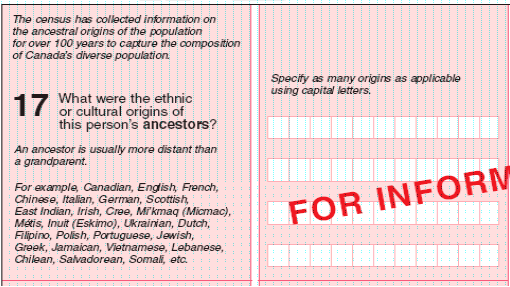
Note that while the ancestry question asked in the 2006 Census 2D form (Northern and Reserves questionnaire) is the same as that asked in the 2B form, the list of examples is different. (See Appendix 1: 2006 Census ethnic origin question from the Northern and Reserves questionnaire (Form 2D)) Data limitations: Comparability of the Aboriginal ancestry (origin) data from different censuses is affected by several factors, including the social environment at the time of the census and changes in the Aboriginal participation over time. The concept of ethnicity is fluid and is probably the most complex concept measured in the census. Respondents' understanding or views about ethnicity (ancestry) and awareness of their family background affect the reporting of ethnicity (ancestry) from one census to another. Increasing intermarriage among various groups has led to an increase in the reporting of multiple origins (ancestries), which has added to the complexity of the ethnic (ancestry) data. Furthermore, reporting patterns are affected by changes in the format and wording of the question, as well as changes in the examples provided on the question. Aboriginal identityAboriginal identity is an indicator of a person's affiliation with an Aboriginal group that is North American Indian, Métis or Inuit.An Aboriginal identity question was first asked on the 1986 Census short questionnaire (Form 2A) which was distributed to all households (100% sample). The results were not published due mostly to problems resulting from misunderstandings of the terminology by the non-Aboriginal population (see Appendix 2: 1986 Census Aboriginal identity question). In 1991, another Aboriginal identity question was tried again, not in the census, but within the first Aboriginal Peoples Survey (see Appendix 3: Identification questions from the 1991 and 2001 Aboriginal Peoples Survey). In 1996, a new Aboriginal identity question similar to the one asked in the 1991 APS was included in the census.2 This same question was also asked in the 2001 and 2006 Censuses. This question reads as follows: 
Note that in the 1996 and 2001 Censuses, the Aboriginal identity counts were derived using three questions, that is by including those persons who reported that they identify with at least one Aboriginal group, i.e., North American Indian, Métis or Inuit, those who reported being a Registered Indian or Treaty Indian as defined by the Indian Act of Canada and those persons who were members of an Indian Band or First Nation. Data limitations: The Aboriginal identity data from the 1996, 2001 and 2006 censuses are comparable. Furthermore, identity data from these three censuses are reasonably comparable to the ancestry data from the 1981 Census.3 However, caution should be exercised in analyzing trends in Aboriginal identity based on previous censuses data. The growth in the Aboriginal identity population has been affected by both demographic factors (birth, deaths and migration) and by reporting changes. The latter refers to people changing, from one census to the next, the reporting of their Aboriginal affiliations from a non-Aboriginal identity to an Aboriginal identity. Registered or Treaty IndianRegistered Indians (also referred to as "status Indians") refer to those persons registered under the Indian Act while Treaty Indians refer to people who are registered under the Indian Act and who belong to an Indian Band or First Nation that signed a treaty with the Crown. The information on Indian legal status was collected in the census for the first time in 1981 as a sub-question of the ethnic origin question. It has been collected as a separate question since 1991. The decision to separate the concept of ancestry from that of Indian status was due to recognition that the latter is one's legal status in relation to the Indian Act, rather than one's ancestral origins. Furthermore, the wording of the 1996 Census question on Registered or Treaty Indian differed slightly from the one used in previous years. Prior to 1996, the term "Treaty Indian" did not appear in the question. It was added in 1996 at the request of individuals from the Western provinces, where the term "Treaty Indian" is more widely used than the term "Registered Indian". It was felt that this change would make the question more understandable to those Registered or Treaty Indians living in the west. The 2006 Census used the same question4 as in 2001 and 1996 which reads as follows: 
Data limitations: The Indian Register5 maintained by Indian and Northern Affairs Canada (INAC) is the other source of data for the Registered Indian population. The different purposes of the Indian Register and the census often result in differences in counts for this population group from each of the data sources. Incomplete enumeration and undercoverage account for most of the difference between the census count of persons registered and the count produced by the Indian Register. Methodological differences, as well as differences in concepts and definitions between the two sources, also account for a smaller part of the difference. Given the numerous differences between these two sources of data, namely in their purposes and coverage, the two sources are not directly comparable. Member of an Indian Band or First Nation This question asks respondents if they are members of an Indian Band or First Nation and if yes, to indicate the name of the Indian Band or First Nation. This information was first collected in 1991 as a sub-element of the Registered Indian question. In the first part of the question, respondents were asked about Indian status, while the second part of the question dealt with Indian Band membership. In 1996, a separate question was developed to collect data on Indian Band/First Nation membership. Many Indian Bands have elected to call themselves a First Nation and have changed their Band name to reflect this. Also, with the 1985 amendment to the Indian Act of Canada (Bill C-31), many Indian Bands exercised the right to establish their own membership code, whereby it was not always necessary for a Band member to be a Registered Indian. Data on Indian Band membership are also available from the Indian Register. The 2006 Census used the same question6 as in 2001 and 1996, which reads as follows: 
Data limitations: Indian Band/First Nation data should be used with caution. The most important causes of the differences in the Indian Band population counts from the Census and the Indian Register are the incomplete enumeration of some Indian reserves as well as methodological, conceptual and collection differences between the two sources. Part 3: Questions used in the Aboriginal Peoples Survey and the Aboriginal Children's Survey to identify Aboriginal peoplesThe 2001 and 2006 Aboriginal Peoples Surveys covered both the Aboriginal identity and Aboriginal ancestry populations, while the 1991 APS focused on the Aboriginal identity population (see Appendix 3 for the identity questions used). In 2006, like in 2001, the APS target population included those persons who were North American Indian, Métis or Inuit, those who were Registered or Treaty Indian as defined by the Indian Act of Canada, those who were members of an Indian Band or First Nation and those who had Aboriginal ancestry. All residents of collective dwellings 7 are excluded from the survey. The first section of the 2006 APS adult and children questionnaires checks that persons selected for the survey do belong to the target population. It asks three of the four census Aboriginal identification questions: Aboriginal identity, Registered or Treaty Indian and Member of an Indian Band or First Nation. However, the words "Inuit (Eskimo)" have been replaced by the word "Inuk", the singular form of "Inuit". A question on Aboriginal ancestry is also asked in the APS but its wording is different from the census ethnic origin question. The APS question deals only with Aboriginal origins and asks whether the selected person has Aboriginal ancestors belonging to an Aboriginal group (North American Indian, Inuit, Métis). Finally, in the 2006 APS questionnaire two questions were added, on application and registration as a Registered Indian under Bill C-31. The 2006 Aboriginal Children's Survey asks the same four questions as the 2006 APS to check whether selected children do belong to the target population: Aboriginal ancestry, Aboriginal identity, Registered or Treaty Indian and Member of an Indian Band or First Nation. Data limitations: The Aboriginal identity data from the census, the Aboriginal Peoples Surveys and the Aboriginal Children's Survey are not strictly comparable due to differences in collection methods, wording of questions, and differing levels of undercoverage. 2006 Aboriginal Peoples Survey identification questions 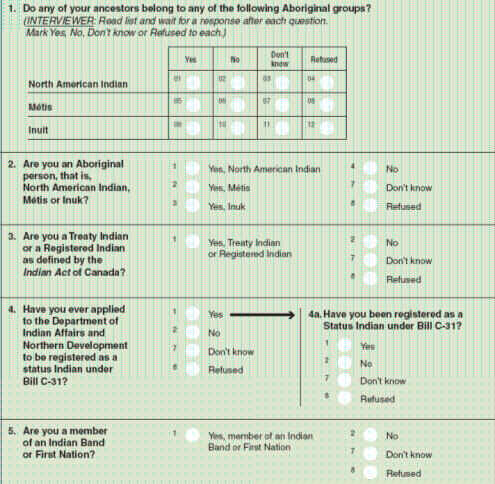 2006 Aboriginal Children's Survey identification questions 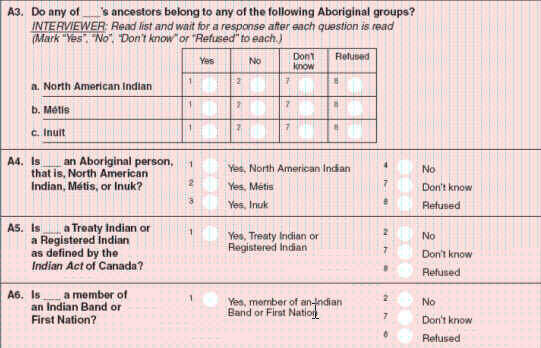
Appendix 1: 2006 Census ethnic origin question from the Northern and Reserves questionnaire (Form 2D) 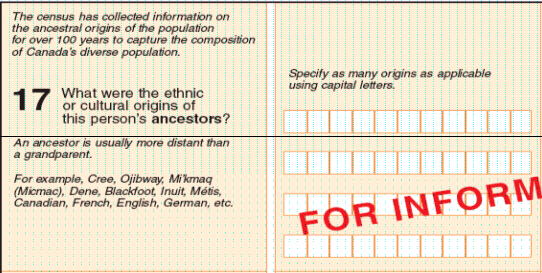
Appendix 2: 1986 Census Aboriginal identity question An Aboriginal identity question was first asked in the 1986 Census short questionnaire (Form 2A) in response to concerns from Aboriginal groups that an individual's ancestry does not necessarily reflect his or her feelings of belonging to a specific group as well as concerns related to census sampling techniques. It was felt that an Aboriginal identity question should be asked on the short questionnaire (100% sample) that was administered to every household and not just in the long questionnaire that was administered to only 1 in 5 households (20% sample).In the 1986 Census respondents were asked: 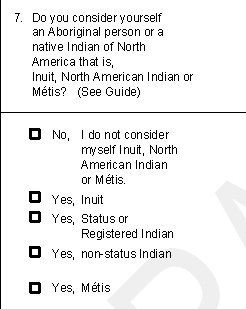 Any person who considered himself/herself a member of any of the Aboriginal groups listed was identified as an Aboriginal person. Overall, data from this question revealed that the Aboriginal identity count was smaller than the ancestry count, and that the two populations had different socio-economic characteristics. A small proportion of the non-Aboriginal population misunderstood the term 'Aboriginal' and answered that they were Aboriginal by checking the first 'yes' box, which happened to be 'Inuit'. It resulted in a 1986 count for Inuit that was double the 1981 count, revealing a problem with the responses to this new question. Appendix 3: Identification questions from the 1991 and 2001 Aboriginal Peoples Survey A new Aboriginal identity question was asked in 1991 as part of the first Aboriginal Peoples Survey. This question was different from the identity question used in the 1986 Census and included a sub-question on Registered Indian status in order to include in the survey persons who did not identify with an Aboriginal group but who were Registered Indians. The 1991 Aboriginal Peoples Survey identity question read as follows:
The 2001 APS asked three of the four Aboriginal questions of the 2001 Census, that is, the Aboriginal identity, Registered or Treaty Indian and Member of an Indian Band or First Nation questions. A question on Aboriginal ancestry was also asked but the wording was different from the census ethnic origin question. The APS question dealt only with Aboriginal origins and asked whether the selected person had Aboriginal ancestors belonging to an Aboriginal group (North American Indian, Métis, Inuit). 
Notes :
You need to use the free Adobe Reader to view PDF documents. To view (open) these files, simply click on the link. To download (save) them, right-click on the link. Note that if you are using Internet Explorer or AOL, PDF documents sometimes do not open properly. See Troubleshooting PDFs. PDF documents may not be accessible by some devices. For more information, visit the Adobe website or contact us for assistance. |
|